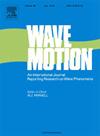Pfaffian solution for dark–dark soliton to the coupled complex modified Korteweg–de Vries equation
IF 2.5
3区 物理与天体物理
Q2 ACOUSTICS
引用次数: 0
Abstract
In this paper, we study the coupled complex modified Korteweg–de Vries (ccmKdV) equation by combining the Hirota’s method and the Kadomtsev–Petviashvili (KP) reduction method. First, we show that the bilinear form of the ccmKdV equation under nonzero boundary condition is linked to the discrete BKP hierarchy through Miwa transformation. Based on this finding, we construct the dark–dark soliton solution in the pfaffian form. The dynamical behaviors for one- and two-soliton are analyzed and illustrated.
耦合复修正Korteweg-de Vries方程的dark-dark孤子的Pfaffian解
本文结合Hirota的方法和Kadomtsev-Petviashvili (KP)约简方法,研究了耦合复变Korteweg-de Vries (ccmKdV)方程。首先,我们通过Miwa变换证明了非零边界条件下ccmKdV方程的双线性形式与离散BKP层次的联系。基于这一发现,我们构造了普氏形式的暗-暗孤子解。对单孤子和双孤子的动力学行为进行了分析和说明。
本文章由计算机程序翻译,如有差异,请以英文原文为准。
求助全文
约1分钟内获得全文
求助全文
来源期刊

Wave Motion
物理-力学
CiteScore
4.10
自引率
8.30%
发文量
118
审稿时长
3 months
期刊介绍:
Wave Motion is devoted to the cross fertilization of ideas, and to stimulating interaction between workers in various research areas in which wave propagation phenomena play a dominant role. The description and analysis of wave propagation phenomena provides a unifying thread connecting diverse areas of engineering and the physical sciences such as acoustics, optics, geophysics, seismology, electromagnetic theory, solid and fluid mechanics.
The journal publishes papers on analytical, numerical and experimental methods. Papers that address fundamentally new topics in wave phenomena or develop wave propagation methods for solving direct and inverse problems are of interest to the journal.
 求助内容:
求助内容: 应助结果提醒方式:
应助结果提醒方式:


